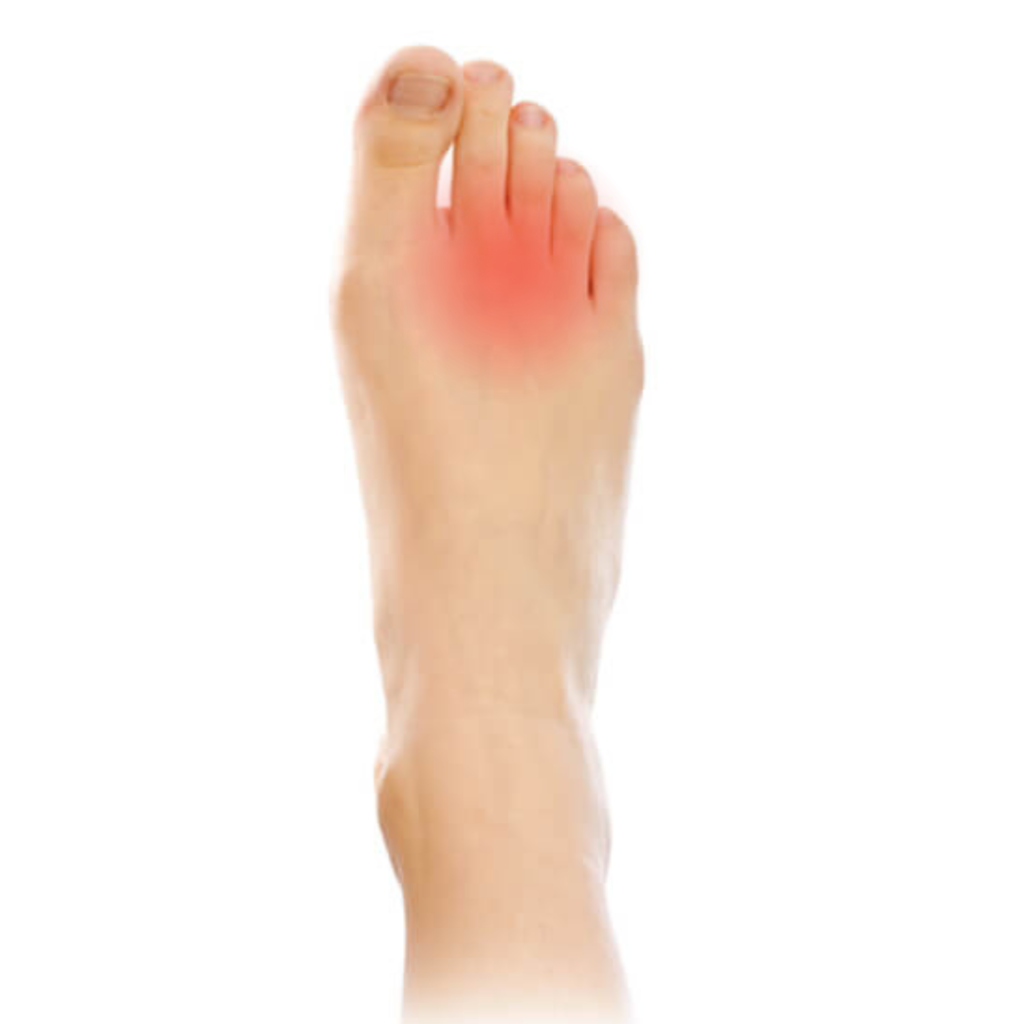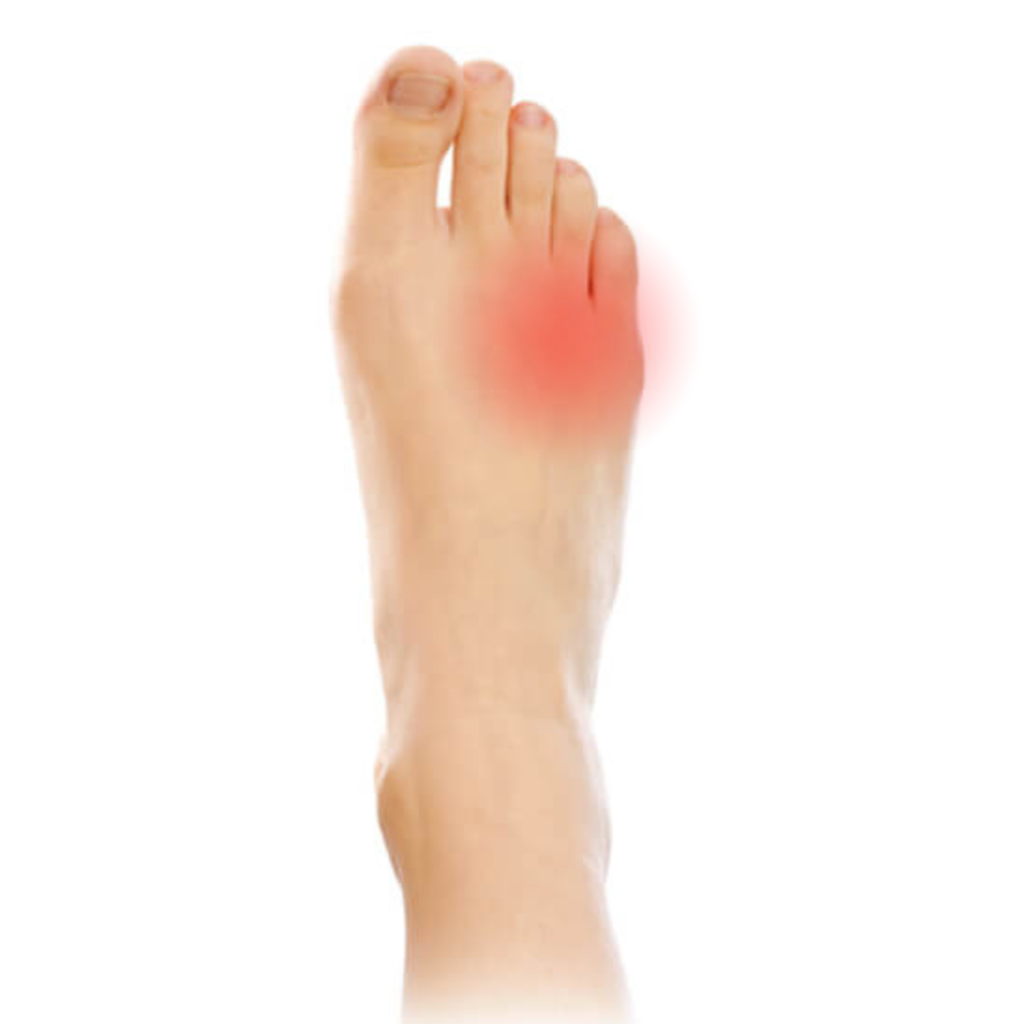Forefoot Conditions
Forefoot Conditions
Forefoot pain can significantly impact mobility and daily activities, causing discomfort in the ball of the foot and toes. From conditions like metatarsalgia to Morton’s neuroma, identifying the source of forefoot pain is crucial for effective podiatric care. This type of pain often results from improper footwear, overuse, or structural abnormalities. The forefoot bears a significant load during movement, making it susceptible to various issues. We are experts in diagnosing and treating forefoot pain, offering personalised solutions. Early intervention is key to preventing chronic discomfort and promoting overall foot health, ensuring individuals can stay active and pain-free. For comprehensive care and relief from forefoot pain, please do not hesitate to book an appointment with us.

Neuroma
A neuroma in the foot refers to a condition characterized by the thickening of nerve tissue, typically occurring in the ball of the foot, most commonly between the third and fourth toes. This condition is often referred to as Morton’s neuroma.
Symptoms
Diagnosis
Treatment
Symptoms
Patients with neuromas often experience a range of uncomfortable symptoms, including sharp pain, burning sensation, tingling, or numbness in the affected area. These sensations can be exacerbated by activities that put pressure on the foot, such as walking or wearing tight-fitting shoes in the toe box area.
Diagnosis
During a podiatry appointment, it is crucial to accurately diagnose and assess the neuroma’s severity. We typically conduct a thorough physical examination and may employ imaging techniques like ultrasound to visualize the neuroma.
Treatment
Treatment options usually include conservative measures such as changing footwear to reduce pressure on the affected area, custom orthotics to provide better support, or corticosteroid injections to alleviate pain and inflammation. In some cases, surgical intervention may be necessary to remove the neuroma and relieve symptoms.
Early diagnosis and appropriate treatment are essential to managing neuromas effectively and preventing further discomfort or complications. Neuromas can be mistaken for other conditions like synovitis or plantar plate injury. We will work closely with you to develop a personalized treatment plan tailored to your specific needs, aiming to alleviate pain and restore your foot’s functionality, allowing you to enjoy a more comfortable and active lifestyle.

Bursitis
Bursitis in the foot is a condition that can cause significant discomfort and affect your ability to move comfortably. Bursae are small, fluid-filled sacs located throughout the body, including the foot, which serve to cushion and reduce friction between tendons, bones, and muscles. When these sacs become inflamed due to repetitive motion, excessive pressure, or trauma, it results in bursitis. In the foot, common areas prone to bursitis include the heel (retrocalcaneal bursitis), the base of the big toe (first metatarsophalangeal joint) and the ball of the foot.
Symptoms
Diagnosis
Treatment
Symptoms
Patients with foot bursitis often experience pain, swelling, warmth, and tenderness in the affected area. Activities that involve prolonged standing, walking, or wearing tight shoes can exacerbate these symptoms.
Diagnosis
During your appointment with us, it is essential to provide a detailed medical history and describe your symptoms accurately to help us make an accurate diagnosis. A physical examination and possibly imaging tests like X-rays may be used to evaluated the biomechanics of your foot and an ultrasound to confirm the presence of bursitis.
Treatment
Treatment options typically include rest, ice, compression, and elevation (RICE), along with anti-inflammatory medications and modifications in footwear. In some cases, we may recommend corticosteroid injections or physiotherapy to manage symptoms and promote healing. Prompt diagnosis and appropriate treatment are crucial to managing foot bursitis effectively, relieving pain, and preventing recurrent episodes, allowing you to maintain an active and pain-free lifestyle.

Synovitis
Synovitis, in podiatry, is a condition that involves inflammation of the synovial lining of joints or tendons, typically occurring in the feet and ankles. This inflammation can lead to pain, swelling, and limited mobility in the affected joints and tendons, significantly impacting your ability to walk and perform everyday activities comfortably.
Cause
Symptoms
Treatment
Cause
Common causes of foot synovitis include trauma, overuse, autoimmune disorders, and certain infections. A physical examination and possibly imaging tests may be employed to confirm the presence and extent of your synovitis.
Symptoms
Patients with foot bursitis often experience pain, swelling, warmth, and tenderness in the affected area. Activities that involve prolonged standing, walking, or wearing tight shoes can exacerbate these symptoms.
Treatment
Treatment options for foot synovitis vary depending on your foot type, the underlying cause, and the severity of the condition. Conservative approaches may include rest, ice, compression, and elevation (RICE), along with non-steroidal anti-inflammatory drugs (NSAIDs) to reduce pain and inflammation. Proper footwear and custom-made orthotics might be recommended according to your foot type and the tendon/ joint that is inflamed. In more severe cases or when conservative measures fail, we may recommend corticosteroid injections to alleviate symptoms and promote healing. Physiotherapy can also be beneficial to improve joint function and reduce pain. The ultimate goal of treatment is to manage inflammation, alleviate pain, and restore normal joint function, enabling you to regain your mobility and quality of life. We will work closely with you and your physiotherapist to develop a personalized treatment plan tailored to your specific needs.

Freiberg's Disease
Freiberg’s Disease is a relatively rare but painful condition that primarily affects the metatarsal bones in the foot, particularly the second metatarsal. This condition, also known as Freiberg infraction, is characterized by the gradual deterioration or necrosis of the metatarsal head due to insufficient blood supply, leading to pain, stiffness, and swelling in the affected area. Typically, it occurs more frequently in adolescents and young adults, with females being more commonly affected.
Diagnosis
Treatment
Diagnosis
During your appointment with us, it’s essential to discuss your symptoms and medical history in detail to aid in the diagnosis. We will conduct a physical examination, which could include palpating the affected area, assessing your foot’s range of motion, and possibly ordering imaging studies to confirm the presence and severity of Freiberg’s Disease.
Treatment
Treatment options for Freiberg’s Disease depend on the stage of the condition. In its early stages, conservative measures such as rest, orthotic devices, and non-steroidal anti-inflammatory drugs (NSAIDs) may be recommended to alleviate pain and reduce inflammation. In more advanced cases, when the joint damage is significant, surgical intervention may be necessary to reshape the affected metatarsal head or realign the joint, ultimately aiming to restore function and relieve pain.
We will work closely with you to determine the most appropriate treatment plan based on your individual needs and the extent of the condition, with the goal of improving your foot’s function and minimizing discomfort.

Stress Fracture
A stress fracture in the foot is a common and painful injury that occurs when there is an overload of repetitive stress on a bone, typically one of the metatarsal bones. These fractures often result from a combination of factors which are non-adequate footwear, faulty biomechanics of the foot, and engaging in activities involving repetitive impact, such as running, jumping, or dancing, or from sudden increases in physical activity.
Symptoms
Diagnosis
Treatment
Symptoms
During your podiatry appointment, it’s crucial to describe your symptoms accurately, which may include localized pain, tenderness, and swelling in the affected area, and provide details about your activity level and any recent changes in your exercise routine.
Diagnosis
We will conduct a thorough physical examination and may order imaging tests like X-rays or an ultrasound scan to confirm the presence of a stress fracture and assess its severity.
Treatment
Treatment for foot stress fractures usually involves rest, immobilization with post-OP shoes or an air cast boot, and sometimes crutches to offload the affected area and allow for proper healing. Additionally, we may recommend modifications in footwear and a gradual return to physical activity to prevent re-injury. Early diagnosis and appropriate treatment are essential to ensure that the fracture heals properly and to minimize the risk of complications.

Bunionette or Tailor's bunion
A bunionette, also known as a tailor’s bunion, is a painful deformity that typically affects the fifth metatarsal bone at the base of the pinky toe. It is characterized by the outward protrusion of the bone and the angling of the pinky toe towards the neighboring toes.
Symptoms
Diagnosis
Treatment
Symptoms
During your appointment with us, it is important to describe the symptoms accurately, which often include localized pain, redness, swelling, and the development of a bony prominence on the outer edge of the foot. You should also provide details about any discomfort experienced while wearing shoes or engaging in specific activities.
Diagnosis
We will conduct a thorough examination of your foot, which may include assessing the range of motion, foot mechanics, and evaluating the severity of the bunionette through physical examination and possibly X-ray imaging.
Treatment
Treatment options for bunionettes typically begin conservatively, with recommendations such as footwear modifications, padding, or orthotic inserts to alleviate pressure and discomfort. In some cases, anti-inflammatory medications and physical therapy may be prescribed. When conservative measures fail to provide relief or in more severe cases, surgical intervention may be necessary to realign the bone and correct the deformity.
We will work closely with you to determine the most appropriate treatment plan based on your individual needs, the severity of the bunionette, and your lifestyle goals. The goal of treatment is to relieve pain, improve foot function, and prevent further progression of the deformity, allowing you to enjoy greater comfort and mobility in your everyday activities.
FAQ
Frequently Ask Questions.
Lorem ipsum dolor sit amet, consectetur adipiscing elit.
Inceptos ut eros aptent commodo semper magna tempor pretium adipiscing. Cursus erat consequat ultrices volutpat eleifend. Ut iaculis lobortis interdum commodo eleifend at ultrices luctus lectus est. Egestas consectetur enim pharetra tempus proin ac quam accumsan efficitur quis dolor.
Inceptos ut eros aptent commodo semper magna tempor pretium adipiscing. Cursus erat consequat ultrices volutpat eleifend. Ut iaculis lobortis interdum commodo eleifend at ultrices luctus lectus est. Egestas consectetur enim pharetra tempus proin ac quam accumsan efficitur quis dolor.
Inceptos ut eros aptent commodo semper magna tempor pretium adipiscing. Cursus erat consequat ultrices volutpat eleifend. Ut iaculis lobortis interdum commodo eleifend at ultrices luctus lectus est. Egestas consectetur enim pharetra tempus proin ac quam accumsan efficitur quis dolor.
Inceptos ut eros aptent commodo semper magna tempor pretium adipiscing. Cursus erat consequat ultrices volutpat eleifend. Ut iaculis lobortis interdum commodo eleifend at ultrices luctus lectus est. Egestas consectetur enim pharetra tempus proin ac quam accumsan efficitur quis dolor.
Inceptos ut eros aptent commodo semper magna tempor pretium adipiscing. Cursus erat consequat ultrices volutpat eleifend. Ut iaculis lobortis interdum commodo eleifend at ultrices luctus lectus est. Egestas consectetur enim pharetra tempus proin ac quam accumsan efficitur quis dolor.
Inceptos ut eros aptent commodo semper magna tempor pretium adipiscing. Cursus erat consequat ultrices volutpat eleifend. Ut iaculis lobortis interdum commodo eleifend at ultrices luctus lectus est. Egestas consectetur enim pharetra tempus proin ac quam accumsan efficitur quis dolor.

